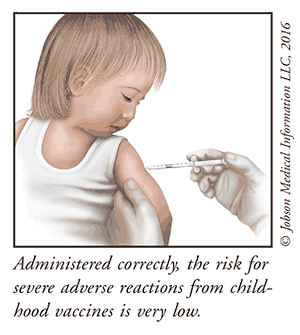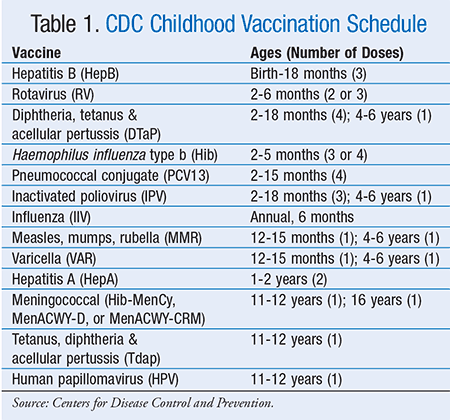US Pharm. 2017;42(5):13-14.
Protecting Against Contagions
Adhering to the recommended childhood vaccination schedule remains the best method for preventing contagious childhood illnesses and protecting the health of children. Children ranging in age from newborn to 18 years are vaccinated to ensure the most complete disease protection possible. While even full vaccination will not prevent every potential childhood sickness, it does reduce the vast majority of problematic and even potentially fatal contagious diseases. Furthermore, serious side effects from vaccines remain extremely rare, varying from about one in 100,000 to one in 1 million immunizations, depending on the specific vaccine.
Vaccines Reduce the Risk of Dangerous Infections
Vaccines work by stimulating the body’s immune system to produce antibodies, or special proteins that fight off viruses. Once formed by the immune system, an antibody is rarely forgotten, and the body can make it again if needed. Therefore, immunization is typically lifelong, and it is why people usually contract diseases like chickenpox only once in their lifetime. Some viral infections—such as colds and the flu—are caused by many different viruses, with new ones appearing each year. For these viruses, scientists create new vaccines every year. Annual revaccination is required for continued protection.

When administered properly, the risk of severe adverse reactions from vaccines is extremely low. Immunizations should be given according to the age schedule, as some small children may not have a robust enough immune system to handle certain vaccines. In some cases, such as having a weakened immune system from certain diseases or treatments like chemotherapy, children may not be able to receive vaccinations at all.
Side Effects and Adverse Reactions Are Rare
In rare cases, individuals may be allergic to some vaccine ingredients. The most common example is the egg components used in many flu vaccines. In these situations, children may receive vaccines made with alternative ingredients instead. Physicians and pharmacists should question patients or their parents about possible allergies before administering immunizations. It is not uncommon for a child to develop a mild local reaction to a vaccine—usually a red, sore spot at the injection site. Certain vaccines may also cause a brief, low-grade fever and mild diarrhea. Children with side effects that last more than a day, or that become severe, should seek medical attention.
In far less than 1% of all vaccinations, severe reactions or anaphylaxis may occur. Anaphylaxis is an intense allergic reaction, and symptoms include a rapid or irregular heartbeat, swelling of the face and throat, unconsciousness, and trouble breathing. Anaphylaxis is a medical emergency, so call 911 immediately if it is suspected.
Vaccinations Are Given According to a CDC Schedule
Currently, all vaccines are administered by injection. TABLE 1 illustrates the primary vaccination schedule for all children issued by the CDC. Many exceptions to the schedule may occur based on existing medical conditions and missed immunizations. For the comprehensive list of recommended childhood vaccinations, visit www.cdc.gov/vaccines/schedules.

Your local pharmacist is here to help! If you, a friend or family member have questions about childhood vaccinations, ask a trusted pharmacist or another healthcare provider.
To comment on this article, contact rdavidson@uspharmacist.com.






